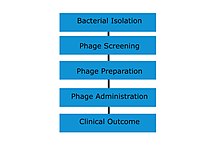User:Millerjk3/sandbox
Treatment of Biofilm Infections[edit]

Phage therapy is being used to great effect in the treatment of biofilm infections, especially Pseudomonas aeruginosa and Staphylococcus aureus.[2][3] From 78 recent cases of treatment of biofilm infections, 96% of patients saw clinical improvement when undergoing phage therapy, and 52% of patients saw complete symptom relief or a full expunge of the effecting bacteria.[2]Biofilms are groups of cells contained within an extracellular matrix, this matrix can allow bacteria to survive in hostile environments, but also makes biofilm infections more challenging to treat with antibiotics;[4]The biofilm matrix and surrounding bacterial membranes can bind to the antibiotics, preventing them from effectively penetrating the biofilm, an they contain enzymes that can deactivate the antibiotics. Biofilm infection cells also have low metabolic activity which means that even if they make it through the biofilm, antibiotics that target growing processes have much lower efficacy. These factors make phage therapy an enticing option for the treatment of such infections. There are currently two different kinds of phages used to treat biofilm infections. The first way is to isolate the initial bacteria and make a specific treatment phage to target it, and the second way is to use a combination of phages selected for their more general effectiveness to.[3] The advantage of the second method is that it can easily be made commercially available for easy treatment, although there are some concerns that it may be substantially less effective. [2]

- ^ Abedon, Stephen T.; Danis-Wlodarczyk, Katarzyna M.; Wozniak, Daniel J.; Sullivan, Matthew B. (2021-06). "Improving Phage-Biofilm In Vitro Experimentation". Viruses. 13 (6): 1175. doi:10.3390/v13061175. ISSN 1999-4915.
{{cite journal}}: Check date values in:|date=(help)CS1 maint: unflagged free DOI (link) - ^ a b c d Pires, Diana P; Meneses, Luciana; Brandão, Ana C; Azeredo, Joana (2022-04-01). "An overview of the current state of phage therapy for the treatment of biofilm-related infections". Current Opinion in Virology. 53: 101209. doi:10.1016/j.coviro.2022.101209. ISSN 1879-6257.
- ^ a b Uyttebroek, Saartje; Chen, Baixing; Onsea, Jolien; Ruythooren, Fred; Debaveye, Yves; Devolder, David; Spriet, Isabel; Depypere, Melissa; Wagemans, Jeroen; Lavigne, Rob; Pirnay, Jean-Paul; Merabishvili, Maya; De Munter, Paul; Peetermans, Willy E; Dupont, Lieven (2022-08-01). "Safety and efficacy of phage therapy in difficult-to-treat infections: a systematic review". The Lancet Infectious Diseases. 22 (8): e208–e220. doi:10.1016/S1473-3099(21)00612-5. ISSN 1473-3099.
- ^ Donlan, Rodney M. (2002-09). "Biofilms: Microbial Life on Surfaces". Emerging Infectious Diseases. 8 (9): 881–890. doi:10.3201/eid0809.020063. ISSN 1080-6040.
{{cite journal}}: Check date values in:|date=(help)

